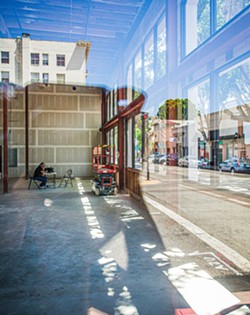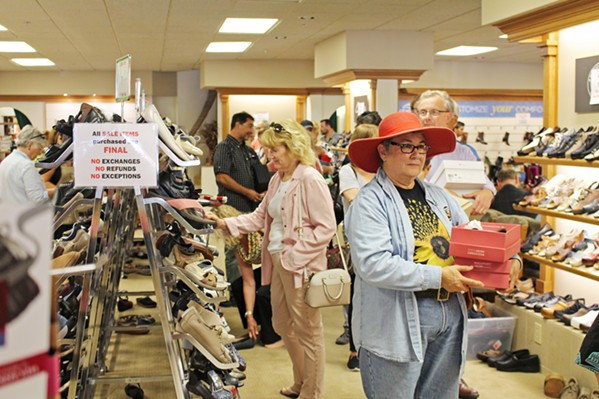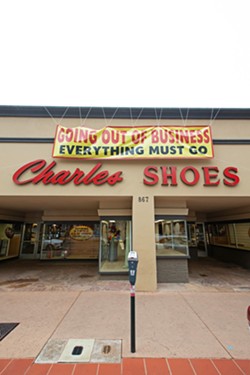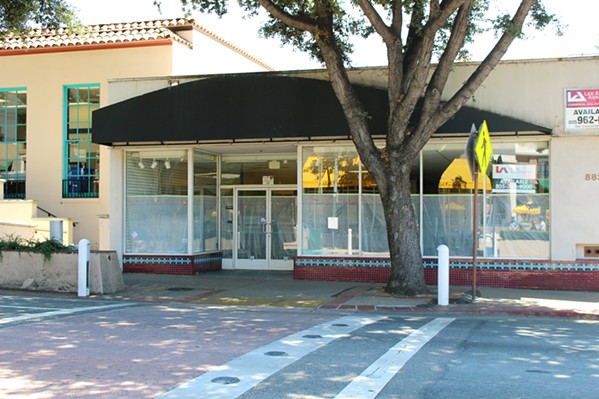What's up with downtown? Recent closures in downtown SLO put a spotlight on tensions between longtime residents and the city's increased focus on tourists and college students
By Kasey Bubnash[{
"name": "Ad - Medium Rectangle CC01 - 300x250",
"id": "AdMediumRectangleCC01300x250",
"class": "inlineCenter",
"insertPoint": "8",
"component": "2963441",
"requiredCountToDisplay": "12"
},{
"name": "Ad - Medium Rectangle LC01 - 300x250",
"id": "AdMediumRectangleCC01300x250",
"class": "inlineCenter",
"insertPoint": "18",
"component": "2963441",
"requiredCountToDisplay": "22"
},{
"name": "Ad - Medium Rectangle LC09 - 300x250",
"id": "AdMediumRectangleLC09300x250",
"class": "inlineCenter",
"insertPoint": "28",
"component": "3252660",
"requiredCountToDisplay": "32"
}]
Starting a business is tough, and in downtown San Luis Obispo, it doesn't always matter how creative or interesting your idea is. If it doesn't cater to tourists, college students, or some new niche, survival is going to be an uphill battle. That's what Rich Hanen learned a little too late after he opened Vegetable Butcher.
When Hanen and his partners opened the restaurant at 712 Marsh St. in July 2017, it was a longtime vision coming to fruition. They'd noticed something about the world today: A lot of different people have a lot of different dietary restrictions.
Whether the diner has a food allergy or a moral opposition to the meat and dairy industries, or he or she is just a good old-fashioned picky eater, those specificities make it challenging for families and groups of friends to find restaurants that cater to everyone's needs. Hanen and his partners imagined a place where a family made up of a vegan kid, gluten-free mom, and steak-loving dad could all find something delicious on the menu at a fair price, without anyone having to settle for a lowly house salad tossed in oil and vinegar.
That's what Vegetable Butcher aimed to do, and Hanen said the San Luis Obispo community initially welcomed his restaurant as a unique place with food for all palates.
But that alone wasn't enough to keep the business alive.
Construction on the neighboring Hotel Cerro overshadowed the restaurant. Main roads surrounding it were closed for days at a time, cranes constantly worked overhead, and there always seemed to be a steady flow of huge work trucks moving in and out of the area. It was noisy and unappealing and chaotic.
"It looked more like a war zone more than a city on some days," Hanen said. "It was a mess."
Hanen and his partners had known about the hotel construction prior to opening Vegetable Butcher and had planned for it, but nothing had prepared them for just how much it would strain business.
The work was repeatedly delayed and nearly two years behind schedule—the hotel still isn't finished—and the reality of the situation was worse than even their worst-case-scenario estimates. Just two years later, in June of this year, Vegetable Butcher closed its doors for good.
Though the construction had a significant impact on Hanen's restaurant, it wasn't the only factor at play. There's a growing "perception" that parking is nearly impossible to find downtown, he said, and it's becoming increasingly difficult for businesses to survive if they aren't directly targeting college-aged residents.
"SLO just isn't as generally busy as we thought," Hanen said.
Vegetable Butcher isn't the only downtown business that's had to throw in the towel within the last few months.
In May, Spike's Pub closed after 38 years in business, following closely behind Formagerie Sophie, an artisan cheese shop that closed its doors in March. El Matador, a taco shop across from Luna Red, closed around that time, too. The Downtown Donut Factory shut down after only a few months in business, as did Branzino, an upscale tapas restaurant that closed in August, five months after it opened. SLO Bike and Run folded in August, alongside both SLO Brew's downtown location and Charles Shoes.
The emptied and shuttered shops are hard to miss, and some longtime residents and business owners say an increased focus on the revenue generated by college students and tourists has put the needs of visitors and short-term residents over the needs of those who have lived and worked in the area for years. But city officials say tourism is vital to the city's economy, and the recent turnover is all just part of the natural ebb and flow of a healthy downtown.
Long-term frustrations
It was uncharacteristically hot in downtown San Luis Obispo on Aug. 15. As some scantily dressed residents took refuge from the heat of the midday sun on shaded bar patios situated along Higuera Street, others rushed into Charles Shoes for the last time.
Inside the store, a line of customers struggling to balance stacks of shoeboxes trailed from the front register all the way to the back of the store. Staffers all around helped search for specific sizes and explained the once-in-a-lifetime deals as dozens of customers hurriedly slipped on shoes and thoughtfully paced back and forth.
Despite the heavily discounted prices, the mood in the store was one of mourning, and a bright yellow sign hanging high above the store's outer entrance made it clear why: "GOING OUT OF BUSINESS: EVERYTHING MUST GO."
The beloved shoe store closed in August after more than 50 years in business. Its longtime owners, sisters Cyndi Ashley and Suzette Porche, decided it was time to retire.
Though the store's closure can't be blamed on any failings of the city or owners, some considered Charles Shoes to be totally unique in today's downtown market—it was geared toward an older demographic of residents—and its loss is representative of the greater issue that is deterring some longtime residents from making the trip downtown.
Odile Ayral has lived in San Luis Obispo since the '70s, and in a message to New Times, she wrote that Charles Shoes was one of downtown's last remaining anchor stores from the "old guard."
"This is a good example of why our downtown is losing more and more local shoppers," she wrote. "Practical stores turn into froufrou stores for the tourists, so we stop going downtown."
Other residents agree.
Griselda Ochoa told New Times that 15 years ago, the city proudly touted a "shop local" slogan. Things have changed drastically since then, and according to Ochoa, chain stores have pushed their way in, and SLO has lost its "small-town charm."
Georgia Adrian wrote in a message to New Times that she avoids going downtown because of the lack of parking and the increasingly present homeless population, issues several other locals noted as well.
Resident Anne Keller said that most retail stores downtown are clearly focused on high school- and college-aged consumers. While she said that's understandable given SLO's demographics, it "does eliminate many of us older folks who might actually want to walk around downtown more often if there was anything of interest to look at or potentially purchase."
These are the issues a group of frustrated residents, Save Our Downtown San Luis Obispo, is pushing the city to address.
Allan Cooper, secretary of the group, characterized the tension over downtown as a "chicken or egg" situation. As college enrollment and tourism numbers grow, the city puts more emphasis on supporting those revenue generators, making the area less appealing to older residents, and thus more difficult for some local businesses to survive.
With two colleges nearby, Cooper said the ever-increasing student population creates intense demand for loud and crowded bars, cheap eats, and live entertainment. Property owners respond by replacing locally owned retail businesses with high-rent-paying entertainment venues, undercutting retail diversity, increasing overall rents, and discouraging older residents from frequenting the area at night and on weekends, when Cooper said the whole main strip feels like "you're inside a disco."
Where there were once useful shops, like hardware and grocery stores, there are now bars and gift shops for tourists.
"The demographics of the city are changing," he said, "and they're changing to the point where the losing constitution are the residents because their needs aren't being addressed downtown."
This is compounded by the fact that the city, because of its growing pension obligations, needs more revenue, which can easily be generated through tourist spending and transient occupancy taxes, fees paid by visitors who stay in local hotels.
So Cooper said the city is fast-tracking developments like Hotel Cerro and Hotel San Luis Obispo, even though they will employ mostly low-salaried workers who likely won't be able to afford the cost of rent in SLO, worsening the housing, commuting, parking, and congestion issues the city already struggles with.
"Downtown shouldn't be seen as a money machine," he said. "It should be seen as a refuge for our residents."
Money maker
Without tourism, it's hard to say what San Luis Obispo might look like.
It's one of the county's top revenue generators, bringing in about $6.7 billion since 2015. In 2018, about 7.5 million tourists visited San Luis Obispo County, generating $80.1 million in tax revenue, according to data collected by Visit SLO Cal, the county's marketing organization. Each household in SLO County would have had to spend an additional $17,231 locally last year to have made the same economic impact.
Much of the money generated by tourism goes back into the city, and that benefits residents, according to the city's Economic Development Manager Charlene Rosales. The city has $40 million earmarked in its 2019-20 budget that will be used to provide improved maintenance, infrastructure, and amenities in the downtown area, she said.
"That goes into all the different things that residents like," Rosales said. "We work really hard to balance the needs of the people who are living here all the time while making it appealing for people who are coming here to visit."
Finding and maintaining that balance is what the Downtown SLO Association is all about, and CEO Bettina Swigger said tourists are vital to the survival of many local downtown businesses.
People are more likely to spend money in brick-and-mortar stores when they're on vacation, according to Swigger. It makes sense: When you're on vacation, you want to walk around and explore. You've saved up and set money aside specifically for the trip, and you want to see stores unlike those you might find at home or anywhere else.
That's why Downtown SLO is excited about the two soon-to-be finished hotels. Despite some complaints that the buildings are ugly, take up much-needed parking, and are too big and too tall, Swigger said the city expects to see a major increase in downtown foot traffic once the hotels open. That means more customers and more profit for all the locally owned shops and restaurants in the core downtown area.
"I think it's an exciting time for downtown," she said, adding that recently opened spaces are part of the thrill.
Swigger admitted that there have been several closures in the last few months, but she said those emptied shops aren't staying vacant for long. New businesses are staking claim and opening their doors to customers.
As the main downtown advocacy organization, with about 600 member businesses, Downtown SLO keeps a close eye on the ins and outs of the local business world. Twenty-two new businesses opened downtown between January and July, Swigger said, 17 of which are locally owned.
The new shops vary greatly in services, from Basalt Interiors, a high-end furniture store that opened in April, to Downtown Baby SLO, a childcare facility that opened this summer. Several, like Mestiza, a luxurious Mexican restaurant that serves $16 tacos and $12 cocktails, are clearly not aimed at feeding and entertaining college kids.
The latest churn is nothing out of the ordinary, Swigger said. If anything, downtown is in the midst of an upswing compared to where it was in January.
"We think that trend is part of a normal, healthy, ever-evolving downtown," she said.
A little perspective
It was 1986, and Shelley Filip had just graduated from Cuesta College when she walked past a help-wanted sign in the window of a surf shop at Avila Beach and snagged the job that would forever define her career.
The owners hired her to manage the store for them while they lived abroad, and she stayed there for 14 years, learning the intricacies of the retail industry.
In 1998, Filip opened her own swimsuit store on Chorro Street in San Luis Obispo, and dubbed it SLO Swim, a business that's still thriving downtown—now at 795 Higuera St.
Over the years, she's built a strong and loyal customer base, she survived the financial crisis of 2007 and 2008, and she's seen a lot of businesses come and go.
She's noticed that some newcomers put a lot of money into renovating and decorating their shops right off the bat.
"Sometimes it's really hard to recover from that because you've dumped so much money into it that you just can't get caught up," Filip said. "And that's true for a lot of people. That's happened to a lot of people."
"As far as display and all that," she told New Times, motioning to her no-frills shop, which lacks ornamental decor but allows for an organized and straightforward shopping experience, "I'm old-school."
Rather than pouring money into interior design, Filip said she pays her employees well and prioritizes supplying her store with a wide variety of swimsuits for all ages, budgets, and styles.
It's not always easy to stay afloat in San Luis Obispo, though. Rents for core downtown spaces range anywhere from about $2.50 to $6.50 per square foot, according to Ryan Benson, a leasing and selling agent with Peak Property Management, and Filip said some of her most loyal customers only come into the downtown area to visit her store. The complaints she hears most often? Not enough parking and too much homelessness. People also tell her there's nothing to do downtown but drink and eat.
But Filip said with the new hotels about to open, she's expecting to see a pretty significant spike in business, so she's not too worried about the current debate over what should and shouldn't be downtown.
She never really was.
"Things are always changing," Filip said. "There's always something being done on our road, there's always something going up. You just gotta roll with it."
That's the attitude residents like Laura Maxwell and Lisa Mackenzie are taking on, too.
Mackenzie said she goes downtown several times a week—she makes a concerted effort to eat and shop local whenever possible. She's never had a problem finding parking, and she's never been bothered by homeless individuals, an issue that she noted is impacting cities nationwide.
Maxwell has only lived in SLO for four years but has been a frequent visitor since the '80s, and she agreed with Mackenzie. She said in an email to New Times that she likes having a mix of national and local stores all in the same core area. She and her family enjoy trying all the new restaurants, and it's easy for them to walk and bike throughout the downtown area.
"SLO is a wonderful place, and while I know all the change is hard for some, you can't fight it so why not embrace it and enjoy it," Maxwell wrote. "We only get one shot at this life, so make the best of it."
If you ask Jim Dantona, president and CEO of SLO Chamber of Commerce, it all comes down to perspective.
To someone who has lived in San Luis Obispo for decades, four-story buildings might seem tall, and paying $5 for a day of parking might seem expensive. To Dantona, who moved to SLO from Los Angeles about eight months ago, these changes feel miniscule.
He saw downtown LA at its best and worst, and to him, downtown SLO feels diverse, vibrant, and welcoming to all kinds of people.
Yes, there are crowded bars that play loud music until 2 a.m. on Saturdays, and there are taquerias serving $3 tacos and cheap beers, Dantona said. But there are also restaurants charging $40 a plate, successful clothing stores for older women, and high-end furniture stores that are obviously not accessible to SLO's college student population.
"I think this community has done a good job at finding balance," Dantona said, "and finding something for everyone." Δ
Contact Staff Writer Kasey Bubnash at [email protected].
Latest in News
Comments (10)
Showing 1-10 of 10
Readers also liked…
-

Coast Unified teachers upset over new position's salary and qualifications
Oct 20, 2022 -

SLO police identify alleged driver who hit and killed couple
Dec 22, 2022 -

When the levee breaks: Oceano residents, county officials walk a tightrope of regulations to manage Arroyo Grande Creek, which some say led to the levee's failure in January
May 18, 2023














